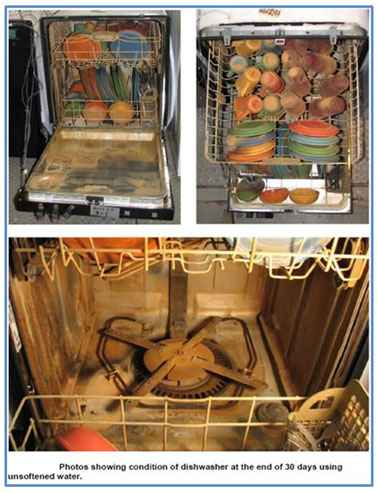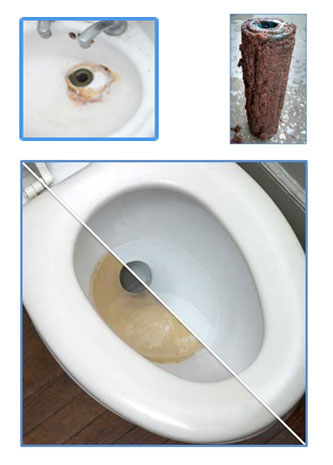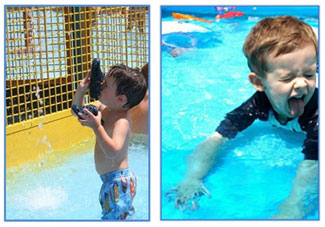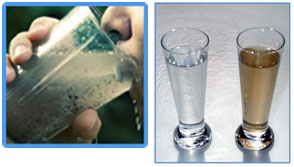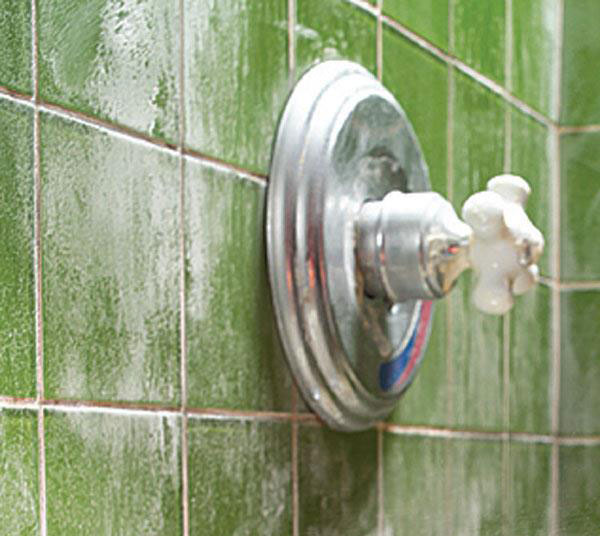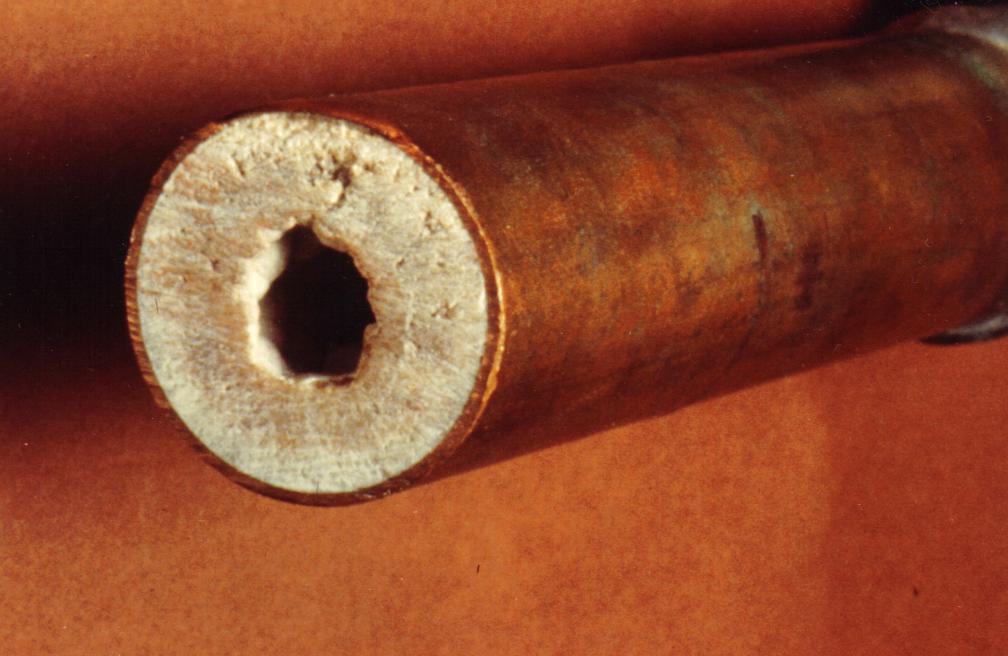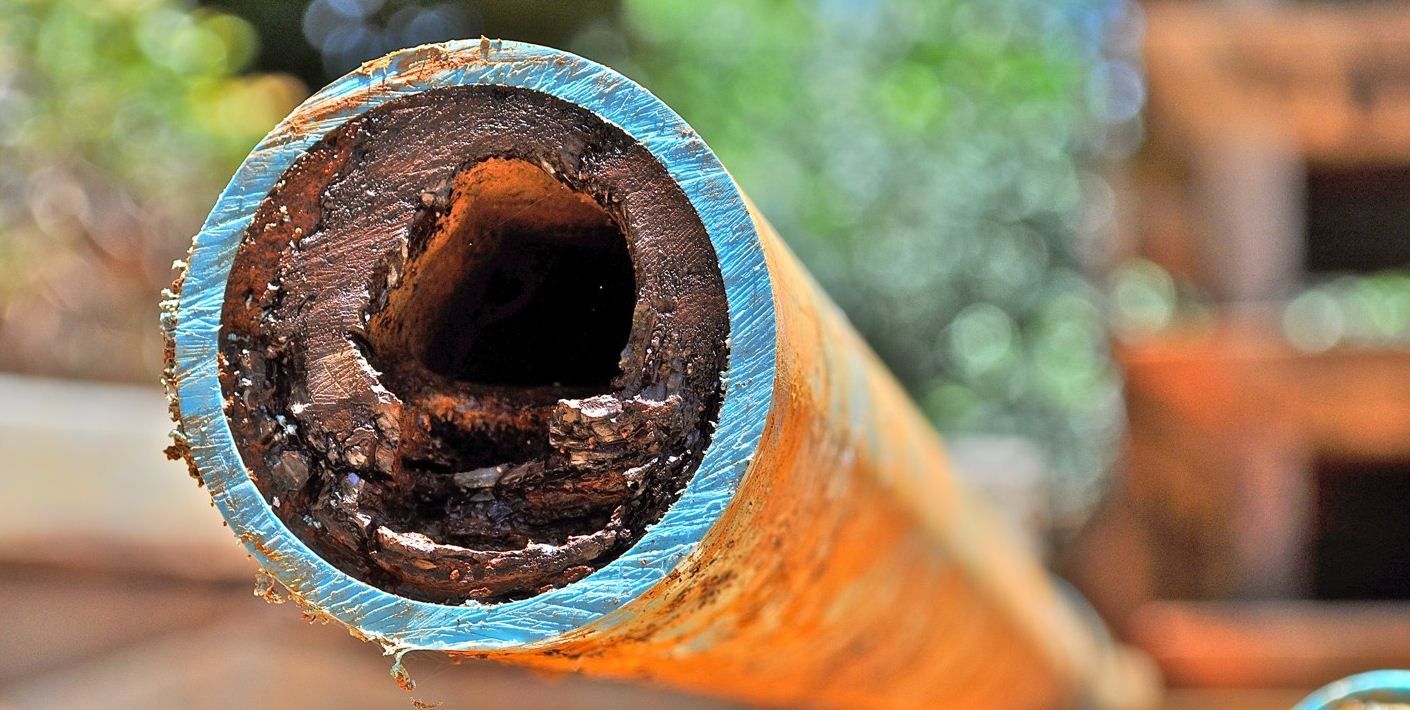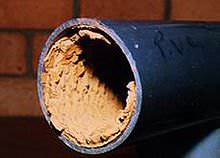Hard Water
Symptoms: Hard water is easy to spot, it leaves a ring in your tubs and sinks made up of hardness, minerals and soap. This scum collects on shower walls, inside your household plumbing and on fixtures and even causes damage to your skin and hair. Hard water can also clog pipes, cause water heaters to operate insufficiently and increase maintenance on water-using appliances. The picture above shows a faucet that has severe calcium buildup and had to be replaced because it was hindering the flow of water in the home. Repairs like these can become quite costly but necessary if you don't treat your water correctly.
Solution: Water hardness is corrected by the use of a water softener . The water passes through a tank containing resin beads holding "soft" sodium ions. The "hard" calcium and magnesium ions are then exchanged for sodium ions, thus softening the water.
Iron Water
Symptoms: Iron water is easy to detect, it may leave iron stains on sinks/tub/showers, clothing/linens or cause iron scaling to form in pipes and water-using appliances that makes your water look and smell bad. A water-test can determine how much iron is present in the home and which type of iron it is.
Solution: After carefully testing the iron content in your water we will correct it with solutions that range from IRON Removal Filters and water softeners to filtration to chemical treatments.
Taste & Odor
Symptoms: Tastes and odors in water do not normally cause physical problems can be very objectionable. You can probably smell the chlorine wafting from your glass of drinking water at times. But wait, that's not right. You should be smelling chlorine in your pool, not your drinking water.
Here's a little known fact: chlorine has been widely used as a disinfectant for drinking water since the early 1900s. Today, chlorine remains the most widely used chemical for water disinfection to ward off waterborne diseases and bacteria.
Solution: Common tastes and odors can be easily treated by activated carbon Filter.
Turbidity
Symptoms: Turbidity is simply dirt or other suspended materials in your water. You can detect turbidity by visual inspection. In addition to being unpleasant to look at, it can clog small water-bearing openings and cause wear on valves, seats and washers.
Suspended materials in water can be trapped in a tank filter containing a bed of filtering Sand Media. Small amounts of turbidity can be handled with a cartridge filter designed for removing sediment from your water supply.
Contaminants
Symptoms: Drinking water contaminants cannot be detected except by professional laboratory testing. These contaminants can be either naturally occurring or man-made.
Depending on the type and amount of the contaminant, there are various methods of treating tainted water, including sediment filters, taste and odor filters, chemical containment filters, lead reduction filters, reverse osmosis drinking water systems and microbiological filtration.
Soft water and hard water are common terms used in households and Industries across the World. If you asked someone what these terms meant, you would probably get a definition based on how well the water cleans when used with detergents or soaps or what is left behind in tea kettles or Utensils.
For example, "hard water is what causes the white scale buildup on my pots," or "soft water doesn’t leave a detergent film on my fresh washed clothes or fixtures." Some might even contend that soft water makes their skin smoother and hair more silky and manageable, "Hard Water has Blocked or Clogged My Industrial Boiler", " Due to hard water My Cooling water Consumes more Chemicals" . While these observations are to be true. It is also important to note that water softeners will not remove any of the more serious drinking water contamination problems. Water Softener Only Removes Calcium and Magnesium Content in Water which Causes Hardness in Water. An understanding of the chemistry of hard and soft water and the treatment process used to produce softer water can help you answer the question, "Do I need to soften my water?"
Hard Water / Soft Water
Whether a water supply is labelled "soft" or "hard" is dependent on the presence of two highly soluble minerals, calcium and magnesium. From a health standpoint, these minerals have no adverse effects and are, in fact, essential daily nutrients. It is minerals that give water the refreshing flavor many people find desirable. However, when calcium and magnesium permeate water, they buildup on contact surfaces, possibly plug pipes and damage water heaters, Bathroom Fixtures, Industrial Boilers and Coolers, Utencils, and decrease the effectiveness of soaps and detergents. At this point the water is said to be hard.
Water hardness is expressed in one of two units of measurement. The first unit is parts per million (ppm) of calcium carbonate, a term equivalent to the concentration of dissolved calcium and magnesium. Using this equivalent simplifies hardness calculations. One ppm means that one unit of calcium carbonate is dissolved in one million units of water. Parts per million is also equal to milligrams/liter (mg/l). A second expression of hardness is grains per gallon (gpg) of calcium carbonate. A gpg is used exclusively as a hardness unit and equals approximately 17 mg/l or ppm.
If you have your water tested, the report will use one or both of these units to tell you how hard your water is. Since the level of calcium carbonate means little to water consumers, water specialists have classified levels of hardness. Table 1 shows these classifications.
Table 1. Water Hardness Classification. |
Classification |
Grains per gallon (gpg) |
Parts per million or milligrams per liter (ppm) or (mg/l) |
Soft |
Less than 1.0 |
Less than 17 |
Slightly hard |
1.0 to 3.5 |
17 to 60 |
Moderately hard |
3.5 to 7.0 |
60 to 120 |
Hard |
7.0 to 10.5 |
120 to 180 |
Very hard |
Greater than 10.5 |
Greater than 180 |
The Water Softening Process
Because water softening devices have long been available in the water treatment industry, the technology is highly developed and in most cases works Best to reduce the hardness level.
How does Water Softener works? A physical and chemical process filters the water through an exchange media known as resin or zeolite. Typically, the resin is a synthetic or natural, sand-like material coated with positively charged sodium ions. As the calcium and magnesium dissolves into positively charged ions, an ion exchange environment is created. The water flows through the unit while the resin releases its sodium ions and readily trades them for the calcium and magnesium ions. The water flowing out of the device is now considered soft.
Regeneration
Clearly the resin is not an inexhaustible exchange site. When all the sodium exchange sites are replaced with hardness minerals, the resin is spent and will no longer soften water. At this point, the water softener will need to be run on an alternate cycle called
regeneration. During this cycle, resin is backwashed with a salt solution. The brine is reverse flushed through the system taking with it the calcium and magnesium ions that had been adsorbed on the resin. Once backwashing is complete, the softener can be returned to use. Some Automatic water softeners will automatically switch to the operation cycle. Others have a manual switch.
Figure 1 illustrates both cycles of the water softening process—ion exchange and regeneration.
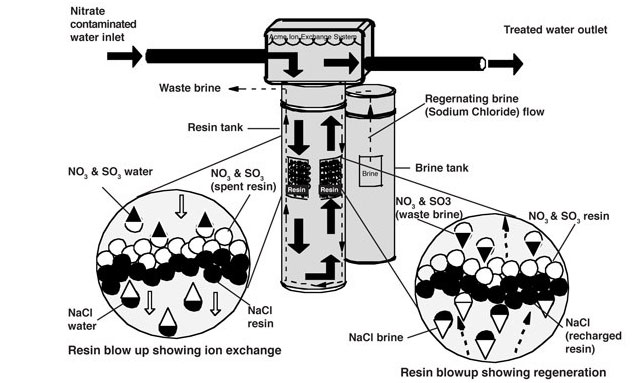 Figure 1.
Figure 1. A typical water softener showing ion exchange and regeneration.
Kinds of softeners
(Although many brands and models of ion exchange units exist on the market, all essentially perform the same with minor differences in extra features, flow rates, etc.
Nearly all softeners fall into one of two categories. Timed models have programmable time clocks that will regenerate on a predetermined schedule and then return to service. These work well for households that are on regular water-using cycles but will waste more water and salt because they regenerate whether the resin needs it or not. Demand-control models, with either electrical and mechanical sensors, usually regenerate after so many gallons of water have been softened. Such models are convenient if you have a fluctuating water use schedule.)
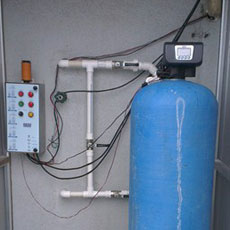
Maintenance
No matter which model/company/Make you choose, all water softeners need to be properly maintained. The brine solution must be mixed and stored in the brine tank. Periodic clogging of the resin also requires special attention. For example, if the raw water supply is turbid it may clog the resin with mud and clay. Sometimes, normal backwashing with water will solve this problem. If not, slowly stir the resin during the backwash cycle to help break up the material. Likewise, bacteria and fungi also form mats in the resin that reduce its effectiveness. Disinfecting the water prior to softening or periodically cleaning the softener with chlorine bleach will eliminate these nuisances. Ask the Suppliers to Clean your Water Softener Resin When Required
Iron fouling is another common maintenance problem for water softeners. Although colorless, reduced iron will be removed by the unit, red-oxidized iron (iron that has been exposed to air or chlorine) will clog the resin. Filtration prior to softening insures that oxidized iron is not processed in the softener. If the resin has already been fouled, commercial cleaners are available.
In some instances, resins cannot be washed of contaminants and will need to be replaced. Consult your water softener dealer for information on resin replacement.
Costs
Water softening costs depend on factors such as installation, maintenance fees, and size of the unit.
You can also expect that with more convenience features, the price of the unit will increase.
Advantages of Water Softening
Most consumers would agree that hard water leaves scales on pots, soap films on skin, and detergent curds in the washing machine. More importantly, scales can also buildup on hot water heaters and decrease their useful life. Soap film and detergent curds in bathtubs and appliances indicate that you are not getting the maximum cleaning action from these products. Soft water not only eliminates these nuisances but also protects appliances and saves cleaning time.
There are other advantages to water softening, as well. It is a well developed technology that has been used for almost 65 years. The equipment is reliable, effective, and widely available, providing consumers with convenient features and a selective market.
